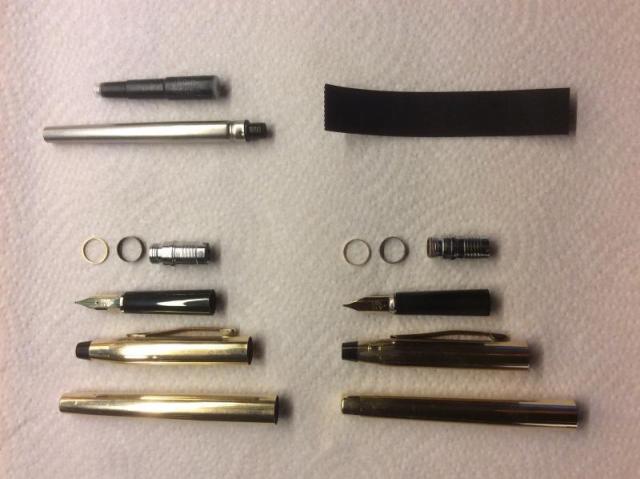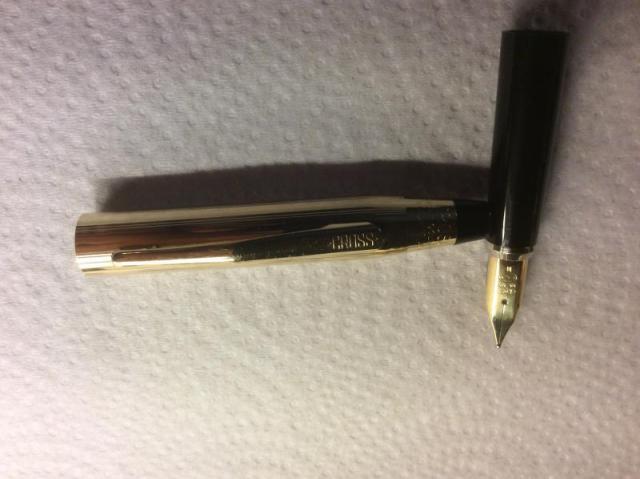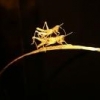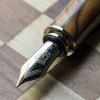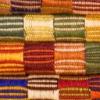Search the Community
Showing results for tags 'century'.
-
Below is a photo of my Cross pen collection. Pens 1-3 are Century ballpoints, 4-6 are Century rollerballs, and 7-8 are Century fountain pens. These are trios of matte black, burgundy, and navy blue with gold trim. The one pen I can't seem to find is a matte navy blue (with gold trim) version of the fountain pen to complete the FP trio, and match the other trios. Did Cross ever make such a pen? Am I searching in vain?
-
Hi, I have got two old Cross classic century gold fountain pens from my father. I'm not sure about the age. They are marked: 1/20 10KT GOLD FILLED with 14KT M nibs. They have problems with ink flow, dryness and scraping. The pens have now been cleaned in water for over 24 hours. No more ink is coming out. But, I have problems removing the nibs for further cleaning and adjustments. Is it possible to remove them at all or are they fixed? They are not moving at all when pulled. I'm trying with a rubber band between my fingers for better grip, but no :-( Hope you have som good solutions for me :-)
-
http://www.platinum-pen.co.jp/fountainpen_century_the_prime.html Wow, Platinum edition and silver edition.... Very hefty price tag. Release date is February 5.
- 39 replies
-
(Disclaimer: This will be a long review of my favorite pen in my current collection. If you want to read just the review, skip to Packaging. Plus, this review is going to be picture heavy.) Introduction: India is a land of great intellectuals and the longevity of the race to reach the top is pretty staggering. May it be an exam that can decide your future or a Periodic Test in Grade 10, exams play a vital role in a student’s life in India. This holds for Indians living in abroad as well. So, it started with me studying hard for my Periodic Tests 2 and I was really hoping to top and get a pen with my own money as until now, my parents bought me all my pens and I didn’t want them to spend 343 AED (around 90 USD) for a pen. I did top my class and as promised, my parents agreed to buy me the Platinum 3776 Century after much negotiation. They expected me to go for something less expensive. But I had topped so there was no backing off. We ordered the pen late at night and my parents gave me the biggest surprise-they didn’t take a single Dirham from me. I ordered from J-subculture along with a converter and chose EMS shipping. J-Subculture took around 3 days to ship it and the pen reached me within 12 days. I was overjoyed when I returned from school and found a package from Japan on the table. Packaging: The pen was well packaged by J-Subculture. As for the pen, it came in a blue faux leather Platinum clamshell case with a white sleeve that my mom threw in the garbage. It contained a user manual, warranty card, and the pen inside a plastic sleeve. The converter came in a simple box. Right of the bat, the converter was a bit rough and I had to grease it with TWSBI silicone grease. Pen and Nib Design (9/10): The pen is named 3776 referring to the height in metres of Mt. Fuji in Japan. It sports a classic rounded top cigar shaped design. I wouldn’t go to the extent of calling it Montblanc inspired as I am pretty sure Montblanc hasn’t patented that design. Talking about patents, this pen’s cap houses the patented Slip and Seal mechanism that Platinum advertises can keep your nib from drying for upto 2 years. The threads are all smooth and you can feel the tension of the cap mechanism after about one and a quarter of a turn. The nib is quite plain with some simple engravings. It is pretty flat in design. The pen is also accentuated with some gold-plated rings and a center band that also has some engravings on it. The engraving on it could be better. I love this design unlike many others. Construction and Quality (7/10): This is a place where this pen kind of lacks behind. The pen feels pretty solidly made with some desirable heft to it. The resin also feels pretty durable, but it lacks in finishing. The pen had some scratches and two of them are noticeable when viewed right. Also, it has two seams on the section which isn’t quite troublesome but can be smoothed out. The engraving could also be better. Looks and Comfort (9/10): The Platinum 3776 Century Chartres Blue is made to look like the stained glass windows of the Chartres Cathedral in France. Most of the 3776 Century fountain pens are French themed with the exceptions of some LE’s that are themed after various locations and lakes around Mt. Fuji. The pen looks stunningly beautiful in blue with some transparency. But, there is a but. The pen looks as it is meant to look only in bright indoor light or in sunlight. Otherwise it looks like a very very deep blue, almost black, with almost no transparency. Comfort wise, the pen could be made a bit more thicker and longer. Only then would it be perfect for me. After posting, this doesn’t matter. Filling System (9/10): It is one of my favorite filling systems. A cartridge-converter is one of my favorites because it is easy to clean, disassemble and also to fill. The only disadvantage of Platinum’s proprietary converter is its small ink capacity. Also, as I mentioned, my converter was poorly greased. Writing Experience (10/10): It is hard to find faults here. The writing experience is stellar. This nib is a champ. The Medium 14 carat gold nib is pretty fine by western standards and writes very smooth with some nice feedback. The ink flow is perfect. This is my kind of nib. I prefer this to overly wet, fat and super smooth nibs. Now I need all the Platinum 3776 century pens with almost all nibs except the Course and the Music. I am not fan of ultra-wide nibs. This nib can be used for various purposes like note taking, daily writing and most importantly long writing sessions with ease. Comparisons: On comparing this pen with the TWSBI Eco and ASA Nauka, the Platinum feels a bit small in the hand and is the second most comfortable out of the three with the ASA bragging the first place. The Platinum easily has the largest nib of the bunch. Conclusion: While this pen is a favorite of mine, it is not without faults. Its construction and finishing could be better, and some minor changes could be done here and there. But these faults won’t stop me from buying the other 3776 Century pens. I need a Bourgogne next as my Chartres Blue needs a companion. Man, I need so many more pens! All the photos were taken with a Nikkon D5300 (I'm still learning to take photos this thing) on a windowsill (my favorite place for pen photography) of my 18th floor apartment with abundant sunlight. They have not been edited. Thank you for reading my review. Please leave your suggestions and comments below.
- 42 replies
-
https://youtu.be/FxlVOQ9t6fg Hey Party People. Here's a review I did of the Platinum 3776 Century. Check it out if you get the chance. Thanks!
-
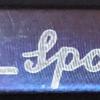
Buy Platinum 3776 Music Nib Separately?
sub_bluesy posted a topic in Fountain & Dip Pens - First Stop
I have a Chartres blue 3776 with a music nib and love it. I picked up a Bourgogne red Century in a soft fine a while back but the nib is not exactly what I was expecting. Consequently I dont use the pen much. I think I had much different expectations of the nib that its just not meant for. I do love the red though! I really would like to swap the nib for a Platinum music nib on the Bourgogne pen and save the SF nib for a different pen. The SF has its place but I would get much more use out of the red pen with a music nib. Is it possible to get a hold of just a Platinum music nib individually or am I going to have to get a whole new pen and start over? Also Im contemplating just getting a C nib and grinding it to an italic with a somewhat music nib profile. Theres a significant cost savings to go that route. The Century music nib is not springy at all so I dont think I would see much of a difference with a hard italic in line width/edges. -
I write really small when for myself (notes, lists, the ever present 5"x8" cards {gasp})... so I want to try an UEF. I generally write with EF and Stub but it's time I try an UEF. Ive found a Platinum Century #3776 UEF for $73 USD delivered. So first, is that a fair deal? Two, is there a cheaper UEF pen for me to try before jumping into a century? Thanks to you all in advance. -B
-
I just received my first Cross fountain pen as a gift. (I'm a Lamy girl usually.) It's a cross century (not a century II) and it came with a broad nib. I'd like to replace it with a fine nib. I've looked on Amazon, Cross website, and other 3rd party sites and cannot find a fine slim replacement nib. If anyone could direct me, I'd be grateful. Also, I'm so thrilled that I found this website. How cool are you guys?!!?
-
The #3776 is a marvellous piece of writing instrument that any passionate fountain pen lover would consider absolutely essential, for building up a collection. Sometimes, it’s one of the top five must haves for people like us, available perhaps at the lowest price given the gold nib. As for me, I never sensed any urgency to get one, as there were a few similar shaped pens (Pilot Custom 74, Sailor 1911 & MB 146) with me. I liked the wide flattish nib and had decided to take a Naka-ai writer later, which would address my desires of getting an urushi lacquered pen in Tamenuri finish. With time however, a few #3776s of my friends passed through my hands and then one fine day the wine red Bourgogne seemed to be unavoidable. I didn't like few of the nibs which I had encountered previously, given their low tolerance to even moderate pressures resulting in higher feedback. The similarly sized and shaped Pilot Custom 74 albeit with a smaller nib, wrote like a dream with just the softness and responsiveness one would ideally want in a fountain pen. The pluses were many if I ended up with the right kind of nib, given a great balance, an unique colour and a air-tight sealing mechanism of the cap. Below links redirects to the same review on my blog with additional eye-candy Platinum #3776 Century in Bourgogne PRESENTATION (6/6) The pen comes in a blue faux-leather gift box, packed with one blue cartridge, a converter, a warranty card and an user manual. I like the simple, no-fuss design of the box with the right amount of protection necessary for the pen. The model number of the pen, in this case tagged to the clip in a small plastic sleeve, PNB-10000 #71, encompasses both the launch price and colour within it. The 10000 refers to JPY 10,000 as the launch price and #71 to Bourgogne, in this case. DESIGNED - CLASSICAL CIGAR (5/6) The #3776 comes with plethora of names and materials ranging from resin to wood to ebonite & celluloids. The ones most commonly purchased across #3776 Century Collection is either the Chartres Blue or the Bourgogne one. The original #3776 series was designed by Japanese playwright Haruo Umeda who was incidentally also known as Mr.Fountain Pen, along with the designers at Platinum, with the intention of creating an ideal fountain pen. The first of the #3776s were made available to general public in 1978. They sold over 150,000 pens in the first six months, gaining popular use. As you might already know, #3776 expresses the height of Mt. Fuji (3776 meters), the highest peak in Japan. This new model however represents the first full model change in over 33 years. You can find a more detailed historical interlude with an amazing review of the Chartres Blue version by Garden Man on FPN. This classical cigar starts with a rounded off finial and a gold plated clip & ring combination, syncing well with concentric cap bands and concluding with a golden dazzle at the end of the barrel. The relatively dark wine red or Bourgogne coloured resin allows light to dazzle through the entirety of the pen. Bourgogne (or Burgundy) is one of France's main wine producing areas. The region is well known for both its red and white wines, mostly made from Pinot noir and Chardonnay grapes, respectively. The pen incidentally gleams in revealing wine red and striking golden hues with ambient light and these effects proliferate with light. The converter shines within, revealing the ink-levels inside. The transparency doesn't give in to all ambience of light, and keeps pacing up with the intensity of red wine. The cap disengages in less than two turns. revealing a golden glaze of the 14k nib. The grip does reveal another knot of glitter, at start of the section here. The barrel further steps down to the section, however it did not affect my writing experience. Injection-moulding threads are somewhat visible at the threads of the barrel and grip, which could have been polished off. Compared to the President nib, the #3776 nib poses serious competition in terms of size and of course flexibility. The cap with a rounded off finial preserves a classical look. A few things etched across a thicker centre band include the symbol p for brand name of PLATINUM, model number #3776 and of course MADE IN JAPAN. An concentric narrow band above renders some differential aesthetics. The simple clip is tension-fit and has a traditional shape, with a faint western resemblance. From top, you can also observe part of spring & screw of the Slip & Seal mechanism inside the finial. This new air-tight screw on cap is supposed to completely seal off the nib tip from outside air, preventing any escaping vapours. The inner cap ‘Slip & Seal’ mechanism was originally designed for the pull-on caps on lower models. In the current design, the forward upraised edge of the section pushes up against the inner cap, the inner cap rotates independently of the outer cap till a spring at the end of the inner cap pushes back the distance, thereby removing the ambient air and achieving an air-tight seal, as seen in this video. This last bit of threads on the barrel (almost the last quarter turn) which activate the air-tight seal in the inner cap, keep the nib from drying out for more than a year, according to Platinum. Overall, the building materials (resin) and the quality of gold plating seem to have improved. The resin seems reasonably resistant to scratches compared to older models but I do see a cap mark on the end of the barrel as I consistently happen to post the pen. FILLING SYSTEM (4/6) As a cartridge converter filler, the supplied convertor is limited by a volume of 0.6 mL although platinum cartridges have an advantage with capacity of more than 1 mL. Unfortunately enough, Platinum stopped manufacturing piston-fillers long back and the last one (70th Anniversary) was released way back in 1989. The #3776 takes in proprietary converters and like all other current Platinum pens and there is an adapter available for international cartridges/converters, whose production is currently stopped. The barrel disengages from the grip section with less than three turns, exposing metallic threads of the section (thus removing the eye dropper possibility). The resin barrel carries the opposite threads inside. The proprietary converter looks cool with its golden trims matching the overall trims of the pen and you can observe the ink levels through streaming transparency of red wine. As you can see, almost the entire converter capacity(albeit limited), remains exposed to your eye. NIB - ALL THAT MATTERS (5/6) The nib #3776 is made up of 14k gold alloy and it comes across in several Japanese widths - EF(Extra-Fine), F(Fine), M(Medium), B(Broad), UEF(Ultra extra-fine), SF(Soft Fine) & C(Double broad). Inscribed within the nib is the symbol of Mt. Fuji’s peak. A hearty breather hole lies above the imprint of a relatively flatly styled nib. Below the etching of #3776 and the brand symbol p, along with nib alloy (14k), width (M) and gold content(585), rest at the far end of the tail. The peaks of Mt. Fuji start parallel to the tines and achieve their summit towards the iridium tipping. These scrollwork are limited to the tines. JAPAN is engraved on one of the faceted shoulders. The nib lays a wet and smooth line and is a tad forgiving to pressure. The black plastic feed for the has spacey and stylish fins and even with the cap open for a while, it does not take an effort to lay a consistently wet line. A small feeder hole at the section end provides ink suction for the converter. This is a redesigned feeder which is wider and thicker than the 1978 one, resulting in a stronger nib alignment. The nib and feed are heat fitted and you are advised not to pull out the unit just for fun. PHYSICS OF IT – RELATIVELY SPEAKING (6/6) The cigar shape of a pen renders comfort and balance for usage. The cap weighs around 10 grams, and I prefer to post the pen to get necessary heft even for extended writing. To take notes or scribble here & there, I don't usually post the pen. The section with around 1 cm girth is another desirable element for longer writing sessions. Along with the converter, the weight and balance are what you would pretty much expect in most of the nicer pens. Length closed ~ 14 cmLength open ~ 12 cmLength posted ~ 16 cmGrip Diameter ~ 1 cmNib Leverage ~ 3.3 cmWeight (with inked converter) ~ 23-24 gWeight of cap ~ 10 g Some snaps of capped, uncapped & posted #3776 with Sailor Pro Gear, Pilot Custom 74 and Pelikan m605 go below for your reference. ECONOMIC VALUE (6/6) The pen retails at around USD 176 in the US or around Rs 10,000 in India, although you can find it significantly lower prices in Japan. I bought the pen at around the street price plus shipping which hovers around USD 80-90. The pen reached me from Pensindia Pune office next day, after placing an order. Honestly, if you are end up with the right kind of nib, this pen is the steal of a deal. It cannot get better than this, given the 14k better-sized gold nib, along with a good body in a comfortable shape. OVERALL (5.3/6) The medium nib lays a width somewhere between a western extra fine and western fine, graced with a wet and consistent flow. With free flowing inks like Waterman, Pilot Standard ones or specific Iroshizukus, the nib glides over paper with great panache. You may feel a bit of resistance, in case of more viscous/shading inks (say MBTB or even Sailors). I did feel some characteristic spring and a hint of softness with the 14k nib. It felt rigid initially, but with constant writing the nib has started to accommodate my pen-pressure with incremental reflexes. The verticals are almost as thick as the horizontals, showing an absence of any unforced line variation. With a decent buffer capacity of the plastic feed and remarkable sealing off mechanism of the cap, the nib starts like a star and glides over the paper with Iroshizuku Yama-budo ink. The ink takes around 20 seconds to dry completely on MD paper, which also points to efficiency as well as economy of Japanese manufacturing. Overall, I am glad that I have finally bought this pen for myself. Thank you for going through the review. You can find other pen and paraphernalia reviews here. REFERENCES Air-Tight Seal of Cap Platinum #3776 Century Website Platinum Izumo - President Nib Review
- 48 replies
-
- platinu#3776
- century
- (and 5 more)
-
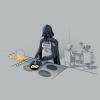
Anyone Knows The Going Price And A Place To Find An 80's Century Fp?
gammada posted a topic in Cross
My very first fountain was a Century black lacquer with gold accents that was a gift from my Father to me in 1986. I still keep the ballpoint and mechanical pencil that came with it, but so far, I've been unable to find a replacement fountain pen. Went to see the current version, but it looks pretty crappy to me. I specially dislike the gold colored section. As such, I would like to know how expensive are they and if it's possible to find them. Thanks for the pointers beforehand! -
Can the new Platinum Century 3776 with its advertised "airtight cap seal" considered totally airplane-safe? I know that any pen with a full converter that does not have any air in it should be safe to travel on an airplane, however sometimes you forget to check what's in your bag or forget to go through the motions of fully filling the pen right before a trip. It would be nice to have a completely "throw-in-the-bag-and-forget" kind of a traveling pen.
-
Platinum #3776 Century Review This is my second review, so please let me know what you think in the comments. Also, there is a review of the Medium version of this pen in Bourgogne, so stay tuned for that. Table of Contents IntroductionPackagingForm Factor and AppearanceNib and SectionConclusion (TLDR)Statistics · Name: Platinum #3776 Century · Nib: 14k gold fine nib · Country of Origin: Japan, imported to US · Model Number: PNB-10000#51-F · Color: Chartres Blue · Price: ¥10,000 retail. Available in the U. S. for ~$150, and from importers for $70 · Included Items: Box, warranty papers, manual, cartridge Part I: Introduction and History In 1919, Shunichi Nakata a Japanese industrialist, founded the Nakaya seisakusho (which according to the company’s website means ‘Nakata: manufacturer of fountain pens,’ in Tokyo, Japan. Nearly a decade later, in 1928, Nakata changed the name to the Platinum Fountain Pen company. In 2011, eight years prior to Platinum’s centennial, the company announced the Platinum #3776 Century fountain pen to commemorate the company’s nearly century long existence. The name of the pen comes from the height of Mount Fuji (in meters). This happens to bear very strong resemblance to the Montblanc Meisterstuck pens, which have the number 4810 (the height of Mont Blanc in meters) embossed on their nibs. The pen also serves as an ambassador, of sorts, as one of the most well-known introductory 14k gold nib pens, along with the Pilot Custom 74 and Sailor Profit 1911 series. It is also an excellent pen overall, and with its street price of $70, it is a brilliant value. The pen is also available with excellent variety, as it is available in eight nib options–UEF, F, M, B, C (double broad), SF, and Music. Its inexpensive price, high build quality, and pleasant writing experience make it one of the most popular fountain pens in the world and one I recommend immensely. <sidenote> Over the past five years, Platinum has come out with a multitude of Limited Edition Centuries to augment the permanent collection of black with gold trim, Chartres Blue with either gold or rhodium trim, and Bourgogne with gold trim. The limited edition pens are contained within two categories, those named after cities, and the ‘Fuji Lake Collection’. There are three limited edition pens named after European cities and neighborhoods—the Nice (which was announced in 2013 and named after the city on the South of France), the Nice Pur (identical to the Nice except for silver accents instead of rose gold), and the Nyhavn (which was announced in 2015 as an Engeika excusive; it was named after the entertainment district in Copenhagen). The Nice pen is clear, with a somewhat clouded resin and rose gold accents. The Nyhavn pen, on the other hand, is much more audacious in design as it has a yellow cap and section along with a rose gold barrel, nib and accents. There are also five ‘Fuji Five Lake Series’ pens: the Mostu (2011, clear resin) Shoji (2012, light blue transparent resin), Sai (2013, clear resin), Yamanaka (2015, clear textured resin), and the final just recently announced Kawaguchi pen (2016, textured blue translucent resin with silver accents). </sidenote> Part II: Packaging (85/100) Functional, could be nicer The pen arrives very well packaged. The exterior box is white, with the Platinum name and logo printed on the front. On the back of the box are Japanese recycling notifications. The actual box of the pen is very similar to those Sailor uses in pens of a similar price range. It is plastic and covered in a faux-leather material that is actually quite pleasant. There are no markings. Once opened, the platinum logo in stitched in gold thread. The rest of the box uses a satin-like white material. The pen sits in a plastic sleeve with a clip-card providing its model number. This is all tucked under a little white ribbon to keep it from moving too much in transport. Unlike, for example, the Pilot box, the base of the Platinum packaging is glued in place. The packaging feels rather brusque. Although Platinum would like to believe that you would leave it on your desk, it is really just something you’ll probably put in a drawer. It will get the pen from A to B safely, but it’s design leaves a little to be desired. Depending on the reseller, the Pen may or may not come with a Platinum converter. As my pen was a Japanese import, it did not, however, I was able to secure one rather inexpensively from the same seller on Rakuten. In the box (in all cases), comes the pen, an instruction manual, and a warranty card. It also comes with one cartridge of Platinum pigment ink. In some cases, it comes with the blue ink, and in other cases (such as mine), it arrived with blue-black ink. Part III: External Form Factor & Appearance — 95/100 The pen is a classical cigar shape with a nice diameter and tapered cap and finial. It is also rather light, being roughly 21 g without ink. It owes this to its plastic construction, which unlike some of its cousins (such as the Pilot C74), does not feel cheap at all. Rather to the contrary, the pen is solid in the hand, with a perfect and weight and measurements to be a lightweight everyday writer. Capped, the pen measures 14 cm long (the cap itself measures 6.7 cm). Uncapped, the pen measures 11.7 cm. The barrel is exactly 8 cm, and the nib and section measure 3.7 cm. The nib itself takes up a majority of the section, measuring 2.2 cm while the section itself measures a comparably small 1.5 cm. However, the writing are is rather large at 2.5 cm long as the threads on the barrel are not sharp and can be used as a grip quite easily. If you prefer to hold your pen higher, the step between the threads and the rest of the barrel is quite small. The pen has a very comfortable diameter of 1.2 cm. Compared with the Pilot C74, which has a 1 centimeter diameter, it is far more comfortable for long periods. During one of my exams two weeks ago, I used this pen to write a seven-page essay, and I can affirmably say that the pen is extremely comfortable. My hand always felt at home on the grip, and it barely even got tired. The pen is made out of strengthened PLA plastic, and when looking at the pen for the first time, you will notice that it is truly beautiful. In the case of the Chartres Blue model, the resin is a rich blue color, with just a touch of translucency. It is really something that you have to try for yourself in order to truly understand, and when you do experience it, it is a sight to be seen. The gold accenting around the clip fit in very well with the resin color and only serve to make the instrument look even better than it already does. However, the resin is a bit more prone to scratching that the Custom 74, due to it sustaining a little scratch after a drop onto hardwood flooring. <sidenote> The pen's color is called the 'Chartres Blue' model because it is based off of the stunning blue stained glass windows of the Chartres Cathedral in Chartres, France. The stained glass windows in the cathedral are known for their deep, rich, blue color, and I think that Platinum did an excellent job emulating that in their pen. </sidenote> The clip is a rounded rectangle sharper angles on the top. It is connected to the cap by a small gold pen, very similarly to the Pilot C74. Near the bottom of the cap are two bands. One thicker, raised band at the bottom which says ‘#3776 PLATINUM MADE IN JAPAN,’ and one thinner band right above it. The cap screws on in 1¾ rotations. However, this cap has Platinum’s ‘Slip and Seal’ feature which is essentially a smaller, airtight cap that secures around the nib and feed, keeping the ink from drying out. When screwing the cap onto the pen, you can feel the mechanism engage in the final quarter turn. Platinum claims that the pen can sit for two years with pigment ink, and upon your first usage in two years, Platinum claims it will start without hesitation. Although I have only had this pen for a matter of weeks, much less years, I have not been able to test this. However, I can say that it has not hard-started once in my possession. The pen also posts quite well. Posted, the pen still remains balanced, however, if you have small hands, it could feel slightly back-heavy. I personally prefer it unposted as it is extremely well balanced no matter your hand size. The pen’s build quality is also top-notch. Never, in my possession, has it creaked or cracked. Although it is made of plastic, the resin feels solid and the pen benefits from its lightness. In comparison to the Custom 74, the pen just feels a little more professional. It weighs a bit more, and it feels like more of a writing Part IV: Nib, Section, and Writing (95/100) The section on the Century is simple, but comfortable. It is 12 millimeters in diameter, and 1.5 cm long. However, the threads on the barrel are not sharp, and extend the usable grip space by another centimeter. There is a gold band on the end of the section that shows where the section ends and the barrel begins. It also has a little lip at the end to keep your hands safely away form the nib. And that brings me to the nib, the defining feature of any pen. This pen is no exception. From a visual standpoint, the nib is rather plain, albeit rather large. It has the Platinum logo, an indicator for nib size and the text 14k and 585, signifying that the nib is 58.5% gold. The word ‘Japan is etched into the right side of the nib’. The only bit of decoration on the nib is that of an etching of Mount Fuji that is simple and tasteful. Below that is the number 3776, signifying the mountain’s height. It also has a breather hole that looks like a heart that I really like. From a design perspective, however, the nib is a little more interesting. It is very broad shouldered, allowing less line variation in the writing. It is also very large. These two factors make the nib hard as a nail when writing normally, but somewhat flexible (not as much as an sf nib), when you try to create variation. As said above, under normal conditions, this nib is very stiff. It will not give an inch unless you press down. However, if you do press down you will most likely punch through your paper because the fine nib is really quite fine, for a fine nib, (and pointy). It is finer that my other Japanese fine nibs and is a hair finer than a Jowo EF or a Lamy EF. Due to this, the pen also gives a fair amount of feedback. In the beginning, the pen may even border on scratchy. However, once your break the nib in, it gives enough feedback so that you can hear it write and you can feel the paper under you. It is definitely not smooth, though. If you prefer smooth, I would recommend you try the Medium nib in this pen, which is very, very smooth (review of that model is coming soon). The pen writes rather neutrally, the ink really determines if it is smooth or dry. So far, I have found that well-lubricated pigment inks, such as the Sailor Blue-Black I currently use with it, suit it the best. The feed has never clogged or hesitated and can write just as fast as I can. I am confident that this pen will be able to write whatever I need it to. If you can deal with a slight amount of feedback, the nib is pleasure to use. Writing sample on 90g Rhodia Part V: Conclusion (TL;DR) — 275 / 300: 92% — Very well recommended Compared to the Pilot, the Platinum is not a pen for fancy, ornamented writing. It is really more of a workhorse device. It is extremely capable, and can deal with pretty much everything I can throw at it. As a student, it is a perfect pen as its fine nib (coupled with the right ink), bleeds through very little, while providing a nice, steady, fine line. It is built well, and very comfortable to write with for long periods. I recommend it highly. Thanks for reading, Caleb
-
Please Help A Newbie Date Or Information About My Cross Pencil
smellrod83 posted a topic in It Writes, But It Is Not A Fountain Pen ....
Ladies and gentlemen I am a newbie when it comes to this, so please anything helps. What I know: I believe it is a century series It is a mechanical pencil It had above the clip, "1/20 gold filled" and "made in USA" words It has a little plastic piece attached to clip that says "18 karat gold filled" The cross logo is in italic letters on the clip The owners book had a few references to a SelecTip Any help in regards to date, or any other information would be greatly appreciated -
Ladies and gentlemen I am a newbie when it comes to this, so please anything helps. What I know: I believe it is a century series It is a mechanical pencil It had above the clip, "1/20 gold filled" and "made in USA" words It has a little plastic piece attached to clip that says "18 karat gold filled" The cross logo is in italic letters on the clip The owners book had a few references to a SelecTip Any help in regards to date, or any other information would be greatly appreciated.
-

Triple Platinum Century 3776 Review: Uef, Sf And B
alexhondsmerk posted a topic in Fountain Pen Reviews
I know this is a pen that is well-known among enthusiasts and has been reviewed several times before, but I own three in different finishes and very different nibs and thought it would be fun to do a little side-by-side review! The Platinum Century 3776 is a classic cigar shaped pen, of medium size, with a very traditional profile; the rounded caps and gently tapered body make for a pen that sits very pleasantly in the hand, posted and unposted. With a capped length of 13.8cm, an uncapped length of 11.9cm, and a posted length of 15.5cm, this is perhaps best suited to medium hands. The section diameter is approximately 1.05cm, the maximum barrel diameter is 1.3cm, and the cap 1.5cm. This is a fairly light pen, at approximately 24g capped and filled, and 14g uncapped and filled. http://i.imgur.com/FUAEeNV.jpg?1 On the subject of filling, these pens are cartridge converter pens, taking proprietary Platinum cartridges or converters. All of mine came with converters, however this may not be standard across all retailers! The piston converter feels of high quality, with a metal and plastic barrel and smooth piston and plunger. An adapter is also available to allow use of standard international cartridges, A thin gold-plated trim ring sits at the base of the section. The section itself is gently tapered, without too big of a step from the barrel to the section, and has a small flare at the end. This contouring guides the hand into a position of holding the pen quite close to the nib; for those who prefer to grip further back, the threads are smooth and not at all uncomfortable to hold. http://i.imgur.com/PrkWKsx.jpg?1 I have three colour variations of the Century; the "standard" black, the Chartres Bleu, and the Bourgogne. All are made from the same resin / plastic, and while the pens are polished to a beautiful shine, the plastic still has a slightly cheap feeling to it? The workmanship is excellent, but it doesn't quite have the heft of a lacquered metal pen or the unique sensation of celluloid or ebonite. What cannot be faulted, however, is the stunning deep colours of the Bourgogne and Chartres pens; a rich wine red and an intense blue respectively. Platinum seems to have run on a French theme, producing pens inspired by Nice, and as here by the wines of the Bourgogne region, and the famous blue stained glass of Chartres cathedral. All these pens have gold plated trim throughout, complementing the rich colours and providing a classic, luxury touch. The blue and black pens are now also available with rhodium trim for those who prefer a silver finish! http://i.imgur.com/NkEO4fN.jpg?1 http://i.imgur.com/n7uXpRD.jpg?1 The caps house Platinum's slip-and-seal mechanism; the inner cap is spring-loaded, as can just be seen in the translucent pens above, meaning that when the pen is screwed closed, the inner cap firmly engages with the section providing an airtight seal around the nib and feed. Platinum claim that these pens can be left for up to a year (!) without drying out; I haven't tested this claim myself, but have never had any problems with hard starts or dried ink in the feed, even if the pens haven't been used in a while. The clip is very functional, plain in design with just a fine border stamped into the metal, and gold plated. The clips are firm but springy, and while easy to clip onto shirt pockets would struggle with thicker material, however they do an excellent job of holding the pens in place! No accidents yet in nearly a year of daily use with these pens. The cap has two trim rings, the wider stamped with "#3776 PLATINUM MADE IN JAPAN". http://i.imgur.com/UUDqE0L.jpg?1 The real star if the show when it comes to the Platinum Century is of course the nib. What you get is a large, brightly polished 14k gold nib, in a huge range of sizes; Platinum offers UEF, EF, F, M, B, BB, SF, and a music nib. I own the UEF, SF and B nibs, and have previously had pens with F and C which I have since sold or traded. http://i.imgur.com/CSr6kjP.jpg?1 The imprints on the nib are perhaps polarising; some seem to like the design, some don't. I think it suits the pen well; the unusual heart-shaped breather hole is a quirky touch, and while the 'scrollwork' is perhaps plain, I don't think this detracts from the looks of these pens. The nib is also stamped with the material data and nib size, and the Platinum logo. Prominently, the #3776, the height in metres of Mount Fuji, adorns the nib; surely this must be a poke at Mont Blanc?! http://i.imgur.com/UZISAG8.jpg?1 What you may notice from the comparison above is that the black and blue pens have a black collar inside the section, and the red has a opal-esque white collar - I assume the reason for tthis is cospetic, as the red is more translucent than the blue and would be muted by black plastic inside. Just look at the difference in the tipping! The double broad/ C nib is even broader, with the most enormous glob of iridium I've ever seen on a nib. See the comparison between UEF and C below? Absolute polar opposites of the production line! http://i.imgur.com/xqbNeTX.jpg The nibs have been universally good out of the box from the 5 I have owned; the fine, broad and double broad have been glassy smooth writers, and the UEF and soft fine have had more tooth, but none has been scratchy; more so a sensation of dragging over the paper? I have been seriously impressed with this, as the fines and certainly the ultra-extra-fine are tiny tips indeed! The standard nibs have a little spring to them, with the UEF being the firmest of the lot. The soft fine is far from a "true flex" nib but adds a pleasant expressive springiness to the writing experience, and one can coax decent swells and hairlines with a little care. The skips in the writing samples below are faults of my very light touch when writing, not of the pens; the feeds keep up admirably with the ink needs, even on the absolute firehose B and BB nibs! http://i.imgur.com/N7NLohg.jpg?1 Finally, and you'll have to excuse the slightly dusty pen chest, how could I not include a picture with a ray of sunlight striking the stunning colours of these pens? The plastics are pretty in themselves, but absolutely glow with a little light behind. http://i.imgur.com/3vqmUo3.jpg?1 I hope you've enjoyed this brief review and comparison; any questions, please ask away! -
Hi. My name is Dan and I'm looking for a new pen. My current pen is a Cross Century (circa 1980's). Decent pen but much smaller than the Pilot 823, which is on my radar . It looks like a Pilot 823 would fit the my needs, but I'm nervous about throwing down $300 USD for a new pen. For folks who have used a much smaller pen like the old Cross Century and now have an 823 (or similar): How difficult was it to switch to a larger pen like the 823?What was your experience changing from a cartridge ink system to a vacuum filling system? Any dislikes and drawbacks? Major likes and benefits?Also: How difficult is it to clean your 823 when you want to try a new ink? What ink do you use in your 823? Inks that perform poorly? Perform very well? Recommendations?Thoughts on the Pilot Iroshizuku inks? If so, what color do you prefer?Also, do you have the Amber or Black 823? Would you buy the 823 again? Other fountain pens to consider (under $300 USD)? Thanks in advance for any help. Dan.
-
Hello, I'm looking to buy a pen from Engeika these days, and can't decide on one of these 2...Black Pilot Custom Heritage 91 and Bourgogne Platinum #3776 century, either with a Soft Fine nib. As far as Japanese pens go, right now I only own a Pilot Decimo and a Smoke CH92, both with Medium nibs, and I really like them a lot...the resin on the 92 really feels great, and the nib is beautifully smooth with a bit of give. I've read a lot of complains regarding Platinum's plastic, which some say feels cheap....I want to know if it's fragile/brittle in any way (more than the Pilot plastic)...I really love the Bourgogne color. So what do you say, is it worth getting another Pilot Custom Heritage (since I really like my first), or should I go for the #3776? Thanks!
-
Hello, I read in a review of this pen that the nib unit is not supposed to come out. https://www.fountainpennetwork.com/forum/topic/291490-platinum-3776-century-chartres-blue-soft-fine-nib/ However, my nib and feed comes out without even a tug. I just have to pull it out casually. Is this supposed to be a bad thing? Thank you.
-

New Cross Writing Instruments Coming In September And October
PenBoutique posted a topic in The Mall
Hello all! There will be New Cross writing instruments coming in September and October! The 2016 Year of the Monkey Special Edition Collection! 2016 Year of the Monkey Special Edition CollectionCross is proud to welcome the latest in our Chinese Zodiac Series – The 2016 Year of the Monkey Collection.The year of the monkey is 9th in the order of the Zodiac cycle. Individuals born under this sign are recognized for their active, energetic spirits and magnetic personalities. They have the versatility, creativity, intelligence and strategic prowess that are the mark of this sign.This exquisite pen is etched with an elegant monkey design and is the perfect addition to your Zodiac collection. Main Features Beautiful Monkey design deeply etched into the finish Available in ballpoint pen, Selectip® Rolling Ball Pen and Fountain Pen technologies Beautiful monkey detail etched into the finish Tibetan Teal and Brushed Platinum Plate finishes add elegance and sophistication Zodiac Special Edition presentation gift packaging, acrylic pen stand and romance book Solid 18KT gold fountain pen nib is decorated with a unique Year of the Monkey pattern Lifetime Mechanical Guarantee Century II & Townsend Holiday Duos! In September 2015! Concept / What’s NewIdeal for the holiday gift giving season, our classic Century II and Townsend ballpoint pen and fountain pen gift sets make the perfect gift for that special someone in your life.Main Features Special Limited Time Holiday Offering Available in ballpoint and fountain pen gift sets Featuring Century II and Townsend collections Includes Gift Box Lifetime Mechanical Guarantee In September 2015 It will be the Edge! Edge New FinishesConcept / What’s New:Introducing two new Edge finishes in expressive and vibrant colors based off the color trends in fashion and beauty!The Cross Edge Collection is known for those who want to have a little fun while getting down to business. The Metallic fusion resin amps up the effect with two new vibrant colors.Engineered to accept gel or ballpoint ink, Edge delivers ultimate function, versatility, and style.Main Features Stylish Metallic Fusion Resin Finishes in Real Teal and Electric Purple Capless rollerball pen Versatile writer accepts both gel and jumbo ballpoint refills Innovative slide-open technology for single-handed operation Premium Gift Box Lifetime Mechanical Guarantee In Feburary 2016 Peerless Collection - Special Edition Cross proudly presents our New Peerless Special Edition Collection - a fine writing series designed to celebrate iconic cities and their citizens around the world.Inspired by the elegant sophistication of New York’s Chrysler Building, London’s Elizabeth Tower and Tokyo’s Skytree, each Peerless pen within this global collection embodies with a premium Swarovski® crystal set into the classic Cross Conical top and designed to showcase each building’s architectural beauty.Main Features Special Edition Collection Available in Ballpoint and Fountain Pen technologies Beautiful architectural detail etched into the finish Embellished with a Swarovski® crystal set into the classic conical top Showcases in a beautiful keepsake box Includes pen presentation stand -
Hi guys! I am a student and I recently bought a Platinum #3776 Century Bourgogne in EF from a reputable eBay seller. I received the pen and I spent 4 hours trying to get it to start and put down a consistent black line. I'm using Noodler's Heart of Darkness. I tried - flushing, cleaning, reinking, cartridge and converter, spreading the tines a little and repeated the whole process many times. I managed to get it to write properly for about an hour but then it started putting down inconsistent lines again. It mostly does this on the faster strokes or on an upstroke. When it is skipping, I pull the feed and nib out and I see that the feed is very dry and almost all of the ink is sitting on the top of the nib. You can see the problem right here: http://i.imgur.com/whKOcoY.jpg http://i.imgur.com/4KPujxl.jpg It used to be much worse than this but I still don't know how to make it write properly. TLDR: - Platinum 3776 EF, inconsistent lines with Noodler's Heart of Darkness, help?
- 12 replies
-
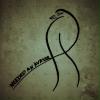
Perceived Scratchiness, Extra Fine Nibs, Nails. Facts/theory/solutions?
Intellidepth posted a topic in Of Nibs & Tines
I've read a lot on here regarding the perceived scratchiness of extra fine nibs. It appears to be a very real phenomenon. What I haven't come across so much are the theories and facts as to why this occurs. I understand how it can and does occur in flex nibs, ie the inside edge of tine can only be smoothed a tiny amount before causing ink to lose connection with the paper. I don't understand how it happens with nails. I understand the difference between feedback and scratchiness. In the main it is scratchiness I am concerned about. However, if you've come across a particular nib made of a particular material that offers reduced vibratory feedback when compared to other nibs in the extra fine (or finer) category, I'm keen to know about it. I'm seeking a nail nib in extra fine for everyday use as my most frequently used note taking pen (possibly a Platinum 3776 Century - maybe even ultra extra fine). I naturally write small. The Lamy fine is too wide with the wet inks I prefer to use. I do understand the stepped difference between Western and Japanese fines. Could people please offer a dash or two of experiential wisdom? Subjective/objective comparisons between nibs you've tried or own, based on the above info, would be most helpful. Alternative pen/nib suggestions are welcome, as are threads on the topic that I may not have come across yet. I don't have access to brick and mortar stores locally that sell a reasonable range of pens.- 15 replies
-
- extra fine
- ef
-
(and 8 more)
Tagged with:
-
Recently I've started thinking about getting into real calligraphy (not just messing around with my Noodler's Ahab), so I went ahead and ordered a Speedball oblique holder just to see if this style suits me...and what do you know, it does! The only problem I have is that I can't insert my currently favorite nib (the Leonardt Steno) in the holder so that the point aligns with the center of the shaft. I started researching and found out that I need an adjustable holder, with a metal flange... Now comes the problem, I really like both the Century and the Zanerian holders, and can't decide which to buy. And to complicate things further, the Zanerian also comes in a shorter version (that long shaft looks pretty thin and fragile?!), and the Century in a thicker version... And then there's the Hourglass Adjustable, with the fixed flange and adjustable by screw. I should mention that I do find the Speedball's grip to be a bit thin. Any advice will be helpful! Thank you! Edit: And then there's the very straightforward, minimalistic (= form follows function), Paper and Ink Arts Adjustable holder (PIA) http://www.paperinkarts.com/piaobl---ros.html ...I'm really not interested in ornament, I just want a holder that's versatile and comfortable to use
- 35 replies
-
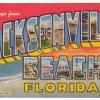
Sailor 1911 Profit Std Federal Blue Vs Platinum 3776 Chartres Blue
mknoblauch posted a topic in Japan - Asia
I was wondering if anyone out there owned a Sailor 1911 Standard Profit in the "Duke & Federal Blue" edition... I first saw this pen on eBay about 6 months ago and was intrigued to find another translucent blue pen a la Platinum 3776 Chartres blue. I stumbled on it again on Engeika's website, and can't stop wondering about it. The "Duke and Federal Blue" looks to be darker than the Chartres Blue color, and I in both the eBay photos and the ones on engeika.com that I saw, the translucence was only noticeable in the close up photo of the cap, suggesting that perhaps the resin on the Sailor might be thicker. Or maybe it is simply owing to the darker color? Both the 3776 Century Chartres and 1911 Standard are great pens are great pens from the reviews I have read, but if anyone has some insight regarding the 1911 Federal Blue, I would appreciate the help. Thanks in advance.- 8 replies
-
- #3776
- sailor 1911
-
(and 4 more)
Tagged with:
-

What Is The Meaning Of These Hallmarks? (Century Classic Ireland)
ANOTHER MIND posted a topic in Cross
I visited a flea market a few days ago and bought a Cross Century set for $43. The price in my opinion was really good and the case and mechanical pencil was a bonus. After a little inspection I found some interesting markings on both of them. Both the fountain pen and the pencil were made in Ireland. I found on the net that if the fountain pen was made in Ireland it is from around 1982. Obviously they are the gold filled versions but there is not inscription like on my USA made ballpoint "-1/20 12kt gold filled". I checked the hallmarks used in Ireland but found nothing similar to these. On the pencil is written "CROSS , Made in Ireland , Plaque ORL" and a little hallmark with a T inside (see photo). The fountain pen has "CROSS , Made in Ireland" and a hallmark on the cap with a shield divided by an "X" with "A C T" (photo) also a similar hallmark is found on the nib "A C T Sté". Even if they seem like a set (in the inside of the box there is an inscription 14kt gold filled) they are diffirent: -Difference #1: the CROSS inscription on the fountain pen is in cursive and on the pencil is printer font -Difference #2: they have different colour pen is more pink and pencil more yellow My questions are: -What is the meaning of those hallmarks on the caps? -Were they from different sets? -Why is there no "gold filled" text on them? -The box is quite large, what was inside the box beside the pen and pencil? Any information, idea is greatly appreciated! Have a nice day! -
As I like my Bourgogne (EF nib), I decided to get the Chartres Blue with an F nib. I saw many pictures of this pen and I am pleased with the actual pen in my hand. Compared to the other #3776 resin body pens, the Chartres Blue (and Bourgogne) is nicely weighed and seems to be well made. I am holding this pen with the Platinum converter; so, the weight of the converter is also contributing to this weight. I like the slip seal cap mechanism and the friction fit closing of the cap. Platinum's friction fit closing is different from the one with MB's Writer's edition. It is difficult to explain in words; but, all I can say is that works flawlessly. I am not a big fan of gold trim, as I like the understated silver or platinum trim. Compared to my #3776 Celluloid Blue, the Chartres Blue shows more bling. But, not to the bling-o-meter scale up to the Pelikan styles, howerver. The 14K nib is the gold trim and the stamping on the nib is the same as my Celluloid's rhodium coated 14K nib, except for the placement of the letter "F." My Celluloid is stamped with F in Japanese. I checked the nib with my loupe and the tines are perfectly aligned. So, it should write very nicely, similar to my experience with my Celluloid's F. I have also posted the family photo. One of my #3776 Sterling silver is missing from this photo as it is in my other place. http://i4.photobucket.com/albums/y115/YS2003/IMG_4718_zpsd6c91944.jpg http://i4.photobucket.com/albums/y115/YS2003/IMG_4724_zps787ef558.jpg http://i4.photobucket.com/albums/y115/YS2003/IMG_4725_zpsccfb10ae.jpg http://i4.photobucket.com/albums/y115/YS2003/IMG_4727_zps8d855d71.jpg http://i4.photobucket.com/albums/y115/YS2003/IMG_4728_zpsbf666c3e.jpg http://i4.photobucket.com/albums/y115/YS2003/IMG_4729_zps27264f1f.jpg http://i4.photobucket.com/albums/y115/YS2003/IMG_4730_zps660862e8.jpg http://i4.photobucket.com/albums/y115/YS2003/IMG_4731_zpsbb0b4f62.jpg http://i4.photobucket.com/albums/y115/YS2003/IMG_4732_zpsdd1b64fa.jpg http://i4.photobucket.com/albums/y115/YS2003/IMG_4733_zps553663c7.jpg http://i4.photobucket.com/albums/y115/YS2003/IMG_4734_zps2c3f34c3.jpg http://i4.photobucket.com/albums/y115/YS2003/IMG_4735_zps28b04c26.jpg http://i4.photobucket.com/albums/y115/YS2003/IMG_4722_zps7922ff95.jpg http://i4.photobucket.com/albums/y115/YS2003/IMG_4726_zpsc63b3304.jpg http://i4.photobucket.com/albums/y115/YS2003/IMG_4723_zpsb562470a.jpghttp://i4.photobucket.com/albums/y115/YS2003/IMG_4719_zps66bb5742.jpg http://i4.photobucket.com/albums/y115/YS2003/IMG_4720_zps5b7a129c.jpg
- 15 replies
-
- chartres blue
- platinum
-
(and 2 more)
Tagged with:




